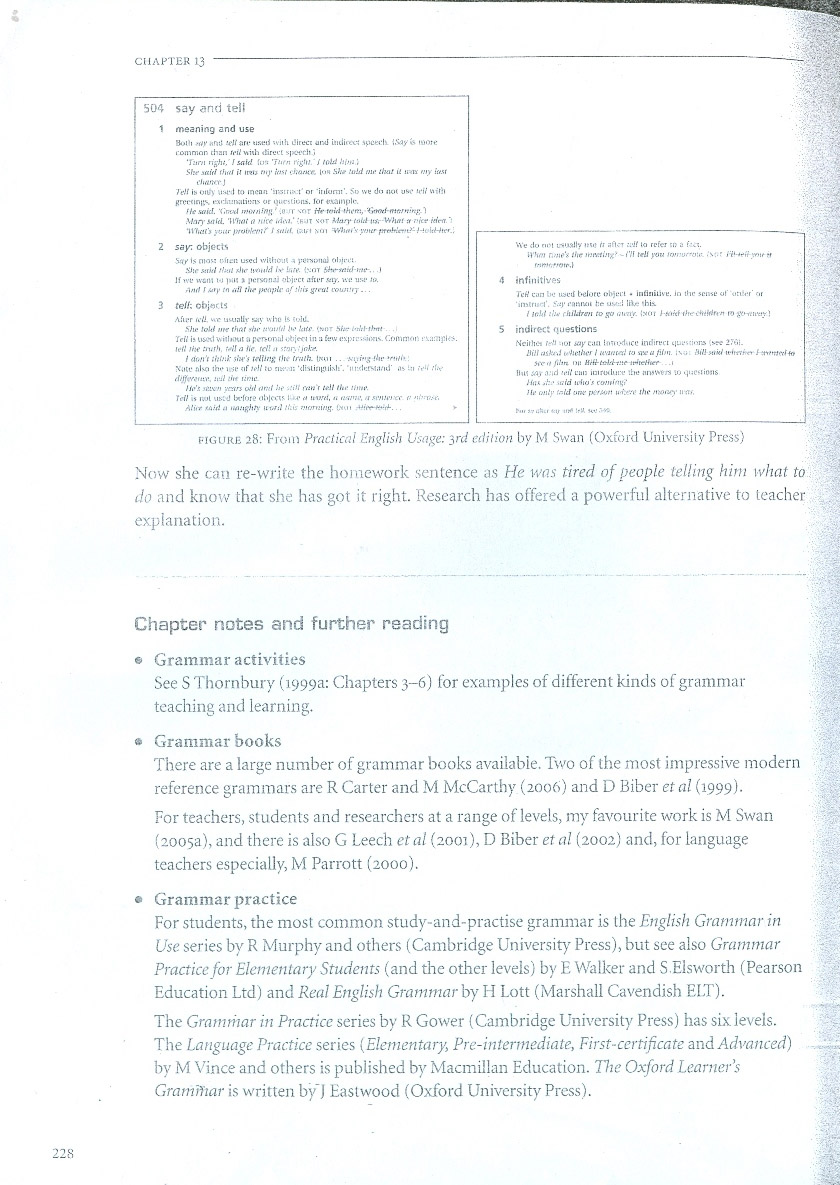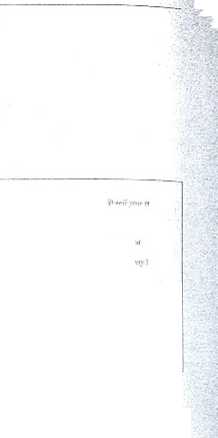0020

504 say and tell
mesning and use
Bulli my «nU ifMOfe ustni witłi diieci ur-d uidinrct 'Sny is moie
l onimnr. tlisn inV wuh duccl s|iO(dd
Tani right/l sald fon Tiitn rigUi i Uild hiw
ikr utul (hut ii lnu my imt (hancg, lun JMw iuid me. thai ii ir<n my iust t-luUKr)
Tell fi* uitfy UMnl to incon 'huiiiM’ 01 'iuiumt'. Si> we <lo uoi uW ifU wilii grcMiniis mi'in!iMtiixi» or cjuotioni. lor mampli*.
He.miel. 'lir.-.w imw/i/01;' .0 'r \fir rfrrmVJ thetts, 'Good-ffwwing. 1 Mary Silili 'IllM/ a ttke oka' -rut sor Mary toid «r-WJurt a ."<<* iiim ' "Wiali jvur y/oO/mi? t suM. ił.ui mu Vthtti‘*ymv prt&timO- HtiM-Jirr;
say. objects
itry ls oiok often u«d vvillicr.it t persona) oliji-ii
Sl:e sald /Uil rhe Ii«mU i'v lr„V. {not iEi-mnlir/e. 1 If wc wam w juk > Jicreonjj objpet aft w fety. we use 10.
And I *»)• cn fili the fHHtpic af :!:is gira! munirj. .
telh objłjr.U
Afirr (eU. wie uwially wy wito Is tollL
She loUI nur that rhe uwild )••• lnie {nor .Sfer t-nil-ihu Ir 11 is wed witli.Mi a F»T>onal in a fcw cxpir --siorwL Oimmon iMimpifS.
1 etl iltf Hulh, Mf/ a tie. (fi! o tnt\ .'jok*.
. |l| -i
Natf nlxo ihi* we <if leli li> nr.-.i: ■diilirigiiisir. irdeWilful' .w ::i '•'|i ."f.v diffwusw. tiul ilu linie
//••i 1 leli i» iv
fun t leli Ute Hitu ,it.:-J before cił*|cct* 1 o mml, /. nrnne, lin nanghry 11 Mil .'.‘.u nionting. !,nn
infinitives
TcH tan bo useil bdorc objr ,iin(ru'-r. rannm be u.v I 10U:!

fi aftrt ::•)! la refer tu a f-rci ling' - li! leli you iwnorfol
11 • m(lniiive. In the iciW o!' o:
:! liir thU
chiUrm togo nurty. Imoi l uń!i/nrc^tkirtn m ■,
indlrect rjuestions
NciiliCł r-''i -iui my can Intiiydwcc indirea c|Uiw:ion» .we 27<<
Mil mh-.l iHtałift I iiiitiift! (a me a film. Ml! suki n-litrrn I ietrn film mi Hłti-tirM-tne iHiditef .1 Hm iny a;id te.it cmi miro.lniT lite niwwers to »|iiC‘iiwis Hm yke Hild teim s eoinlmfi Ile mi ty t.-id ow pirMi &ist*e the iwuty 11 w.
Ni. >7
ma !rl* w
figurę 28: Froin Praciiail English Usage: yd edilion lny M Swan (Orford University Press)
Now she can re-write the homework sentence as He was tired of peapie telling him do and know that she has got it right. Research has offered a powerful alternative to exp!anation.
what to teacher
Chapter notes and further peading

® Grammar activities
See S Thornbury (iy99a: Chapters 3-6J tor examples of different kinds of grammar tcaching and learning.
® Grammar books
There are a large number of grammar books avaiiabie. Two of the most impressive modern reference grammars are R Carter and M McCarth}' (2006) and D Biber et al (1999)-For teachers, students and researchers at a rangę of levels, my favourite work is M Swan (20osa), and there is also G Łeech etal (2001), D Biber et al (2002) and, for language teachers especially, M Parrott (2000).
® Grammar practice
For students, the most common study-and-practise grammar is the English Grammar in Use series by R Murphy and others (Cambridge University Press), but see also Grammar Practice for Elementary Students (and the odrer leveis} by E Walker and S.Elsworth (Pearson Education Ltd) and Real English Grammar by H Lott (Marshall Cavendish ELT).
The Grammar in Practice series by RGower (Cambridge University Press) hassixleveis.
The Language Practice series (Elementary, Pre-intermediate, First-certificats and Admnced) Lii.
by M Vince and others is pubiished by Macmillan Education. The Oxford LearneEs GramYftar is written by’J Eastwood (Oxford University Press).
Wyszukiwarka
Podobne podstrony:
WELCOME 1 ĆWICZENIA 13 mm UNIT.V 3 i;J/ Fili in.- a or an. mm o rangę tree apple 5 .........armcha
00014 L28ee5aa5f5654405d1c5056d87a4de 13 An Overview and Perspective on Control Charting enough to
:ACTM Acta Sci. Poi, Medicina Veteriiiaria 7(4) 2008, 13-20 SAFETY AND QUALITY OF MILK PRODUCTS FROM
page9 5 Look, say and write. read / write play soccer / play sirig /
37933 Obraz22 Muting durlng Car Telephone Calls "**13 e ep**one and if lho
jow05 08 . 13, 14, 15, and 16. 9, 10, 11. and 12. and 20. prnotlco, ln tho neralng, 5xorclaoa 5
w w w. we ka. p w r. w roc. p I 13 ■ Advanced Informatics and Control (II st. w ję
V.A4-U-£x-l3-Ł-«4 Cob. 69W-MN-9761-13. 2 1. XL, YL, and ZL are thc thrce partner*
13 DSC00544 palaces and hundreds of church spires for which Prague is renowned. The monumental c
Carlos M Teixeira sao paulo skyscraper 21 13 . Meantimc engmeers and interna kep< on with an ms
13 The Ideological and Cultural Dimensions 145 sed after his death by miracles that occurred ne
83 6f6936accc INSPECTION AND REPAIRENG m 4-13 Warpage measurement and resurface-ment steps: •Attach
więcej podobnych podstron